MeldaProduction MStereoSpread Bedienungsanleitung
MeldaProduction
audio-software
MStereoSpread
Lies die bedienungsanleitung für MeldaProduction MStereoSpread (111 Seiten) kostenlos online; sie gehört zur Kategorie audio-software. Dieses Handbuch wurde von 4 Personen als hilfreich bewertet und erhielt im Schnitt 4.3 Sterne aus 2.5 Bewertungen. Hast du eine Frage zu MeldaProduction MStereoSpread oder möchtest du andere Nutzer dieses Produkts befragen? Stelle eine Frage
Seite 1/111

MStereoSpread
MStereoSpread is a unique artificial stereo generator. It implements 2 algorithms, the first a high-end spectral algorithm, which is preferred
and provides unbeatable audio quality, and the second a fairly common algorithm based on comb-filtering. You can use either one or both of
them at the same time. The plugin also provides additional controls such as a stereo width knob, and a stereo field analyzer.
Basics of stereo field psychoacoustics
A healthy human possesses two ears and since birth, our brain has been using them to learn to identify different sounds and their origins.
After years of practice we are able to identify sounds inside whole mixes and estimate the direction and distance to the sound origin with
surprising accuracy. We are even able to guess the size and type of the room we are in. All of this done using just our two ears, both of
which are essentially just one dimensional.
The invention of stereo audio gives a mixing engineer unprecedented possibilities, which are way beyond the basic panorama. The fact that
our brain can extract different parts of a mix gives us another two dimensions which we can use to make a mix "clear". A mixing engineer's
task is to make the listener understand the mix easily and let them focus on what is important without actually thinking about it and
analysing the audio. Here we'll discuss the basic clues that our brain uses to identify the origin and explain why and how we can take
advantage of these clues.
Left or right
When an audio source is on the left side, it is natural that you will hear it first using your left ear, then you will probably get some reflections
and resonances from your skull to your right ear. Note that this makes perfect sense, yet most people still use a panorama control to make
a sound come from the left side! In the real world that's something that would only happen in an anechoic chamber with a dampening
device attached to your head! It may sound acceptable when using monitors, because the environment actually creates the reflections for
you and the skull resonances are again present, but it just doesn't sound natural with headphones. However the majority of us use
headphones every day so it is essential to learn to simulate direction using more advanced techniques.
To summarise: Sounds coming from our left side occur first in our left ear and then get slightly delayed, lowered/attenuated, filtered in our
right ear and are followed by a set of reflections. It is usually not necessary to simulate the reflections and the filtering cannot actually be
simulated, because every skull is different. So all that is needed is to delay the right channel and attenuate it slightly. This is usually called a
Haas delay.
Direction
Things get more complicated when the audio is not coming from completely left or right, but from any angle around you. This is where the
ear filter comes in. When you look at an ear, you may wonder why it has such a weird shape. The interesting thing about this is that it
actually looks different from every angle. And it also changes the sound from every direction differently . We can actually simulate this, by
placing a tiny microphone into our ear, recording impulse responses from different angles and then use these to convolve any audio with it
to make it sound like "it originated from there". Unfortunately tests have shown that each person has different ears and after the years the
brain has taken to adjust to them, using a 'different person's ears' doesn't work very well.
So how can we simulate a sound coming from say 45 degrees to your left, and 60 degrees above you? Well, it seems that we cannot do that
effectively using just 2 channels. After all it wouldn't work with monitors anyway, only in headphones. Luckily for us, we don't really need
vertical placement, and a Haas delay seems to be enough to make a sound originate from in front of us from any horizontal angle.
Distance - how to make a sound appear further away
A sense of distance is much more useful and interesting and it can even be partly applied to monophonic audio too. First, is the air
absorption of higher frequencies - sounds originating from a longer distance have substantially lower levels of higher frequencies, because

sound traveling is more energetically demanding for higher frequencies. Secondly, the human brain uses reflections from surrounding
objects. The further away the sound source is, the more reflections there are likely to be. It is usually called the ratio between the direct
signal and reverberation. Both of these effects can be used in mono.
Now we can finally get to the concept of the stereo image. When the audio source is very far away in front of us, both ears would probably
intercept almost the same sound, the difference would only be in the surrounding environment, e.g. a wall on your left side would probably
be very audible. This level of detail however is not usually relevant for mixing, so we can simplify it and say that in this case the sound
would basically be monophonic. A rule of thumb - distant objects are nearly monophonic.
Moving a sound further away is therefore pretty simple - add some reverb, attenuate high frequencies using an equalizer, and collapse the
stereo image using the Widening controller for example.
Distance - how to make a sound appear closer
When a sound source is very close to your head it is likely that both ears will intercept the sound more or less at the same time, there will
be no loss of high frequencies and any reflections would be negligible compared to the direct signal. This may lead to the conclusion, that a
monophonic audio track positioned in the center is as close as it can be (as long as it doesn't have too many reflections recorded). But this
is not really true.
By making the audio in both ears uncorrelated (or just different) you can fool the brain into thinking that the audio is closer than is
physically possible, thus making the sound actually appear inside your head. A rule of thumb - the closer the object is, the more
stereophonic it is.
This effect is now used extensively in modern tight mixes. The main challenge is how to make it sound natural as this doesn't actually occur
in nature. The sound in both ears must be similar enough for the brain to put both pieces together, otherwise they would sound like 2
separate audio signals and that can be very tiring on the ears. But these 2 channels must also be different enough to cause this proximity
effect.
What you need is an artificial stereo width. Reverbs are often employed for width, but as you now know they also make the audio sound
further away and create a sense of space, which cannot occur if the sound source is "in your head". Another way is to use a chorus or a
similar modulation effect, but these modify the sound in a way that is not transparent enough and in most cases they also psycho
acoustically shift the sound source further away.
And that's where MStereoSpread comes in.
Why do we care about sound origin?
When you listen to a mix that is crowded, it is very fatiguing. It often sounds like all the instruments are at the same location, or everyone is
in a different space, or you just cannot say anything about it, because the whole thing just doesn't make sense intuitively. This is often hard
to judge, especially for untrained ears, and engineers start playing with volumes and panoramas. However the point is - a good mix must
make the listener feel like they are in a specific place and all of the instruments are on stage. That's a natural way for our brain to separate
instruments, because in real life it is impossible to have multiple instruments existing at one place.
Good mixing engineers will employ one or more reverbs to make some sense of space and glue the tracks together. They will also apply
several other techniques, some of which we have already described, to place each track into a specific spot on stage, whether it is at the
end, right next to the listener, or inside their head. And what does the listener focus on? The sound that is closest, of course.
Simply put, the least important tracks should appear far away, hence monophonic, highly reverberated and without many high frequencies.
Most important tracks are the exact opposite - as close as possible, so stereophonic, minimum reverberation and with as much original
clarity in the high frequencies as possible.
What is artificial stereo?
MStereoSpread modifies both channels, left and right, differently so that when summed together they recreate the original signal, just the
phase is altered but in a very natural way. This way the brain can put both channels together, yet it simulates the proximity effect making
the audio materials sound highly stereophonic, close, but still natural.
The plugin uses 2 algorithms. The first, a delay-based generator which is a well-known concept used in several other plugins and is provided
here only for comparison as it has several flaws. The second, a spectral generator that provides unbelievable clarity and naturality, is
therefore always recommended.
Presets
Presets button shows a window with all available presets. A preset can be loaded from the preset window by double-clicking on it, selecting
via the buttons or by using your keyboard. You can also manage the directory structure, store new presets, replace existing ones etc.
Presets are global, so a preset saved from one project, can easily be used in another. The arrow buttons next to the preset button can be
used to switch between presets easily.
Holding Ctrl while pressing the button loads a random preset. There must be some presets for this feature to work of course.
Presets can be backed up by 3 different methods:
A) Using "Backup" and "Restore" buttons in each preset window, which produces a single archive of all presets on the computer.
B) Using "Export/Import" buttons, which export a single folder of presets for one plugin.
C) By saving the actual preset files, which are found in the following directories (not recommended):
Produktspezifikationen
| Marke: | MeldaProduction |
| Kategorie: | audio-software |
| Modell: | MStereoSpread |
Brauchst du Hilfe?
Wenn Sie Hilfe mit MeldaProduction MStereoSpread benötigen, stellen Sie unten eine Frage und andere Benutzer werden Ihnen antworten
Bedienungsanleitung audio-software MeldaProduction
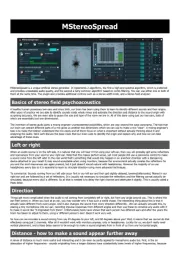
24 August 2025
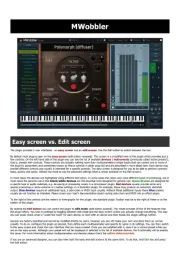
24 August 2025
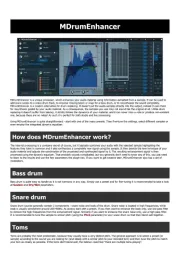
24 August 2025
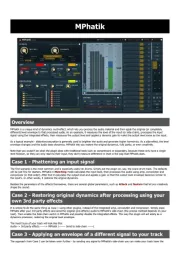
24 August 2025
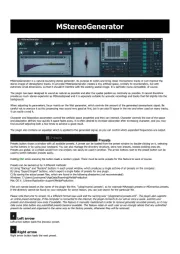
24 August 2025
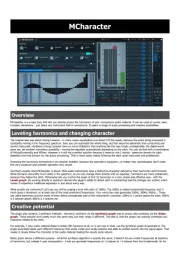
24 August 2025
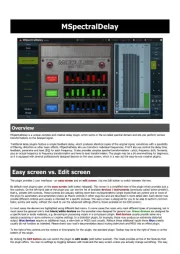
24 August 2025
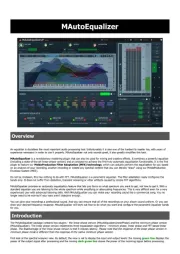
24 August 2025
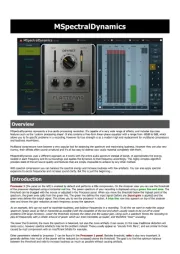
24 August 2025
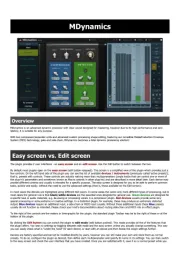
24 August 2025
Bedienungsanleitung audio-software
- Corel
- Arturia
- AVID
- FabFilter
- MixVibes
- Antares
- PreSonus
- Native Instruments
- CEDAR
- PSP Audioware
- Best Service
- Metric Halo
- Steinberg
- MIA Laboratories
- Blue Cat Audio
Neueste Bedienungsanleitung für -Kategorien-
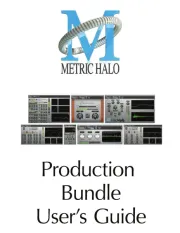
24 August 2025

24 August 2025

24 August 2025
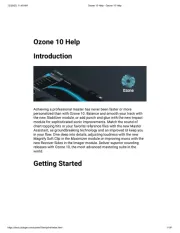
24 August 2025
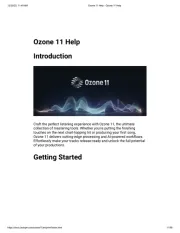
24 August 2025
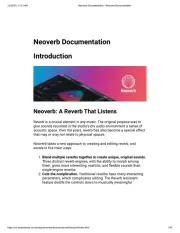
24 August 2025

24 August 2025

24 August 2025

24 August 2025

24 August 2025